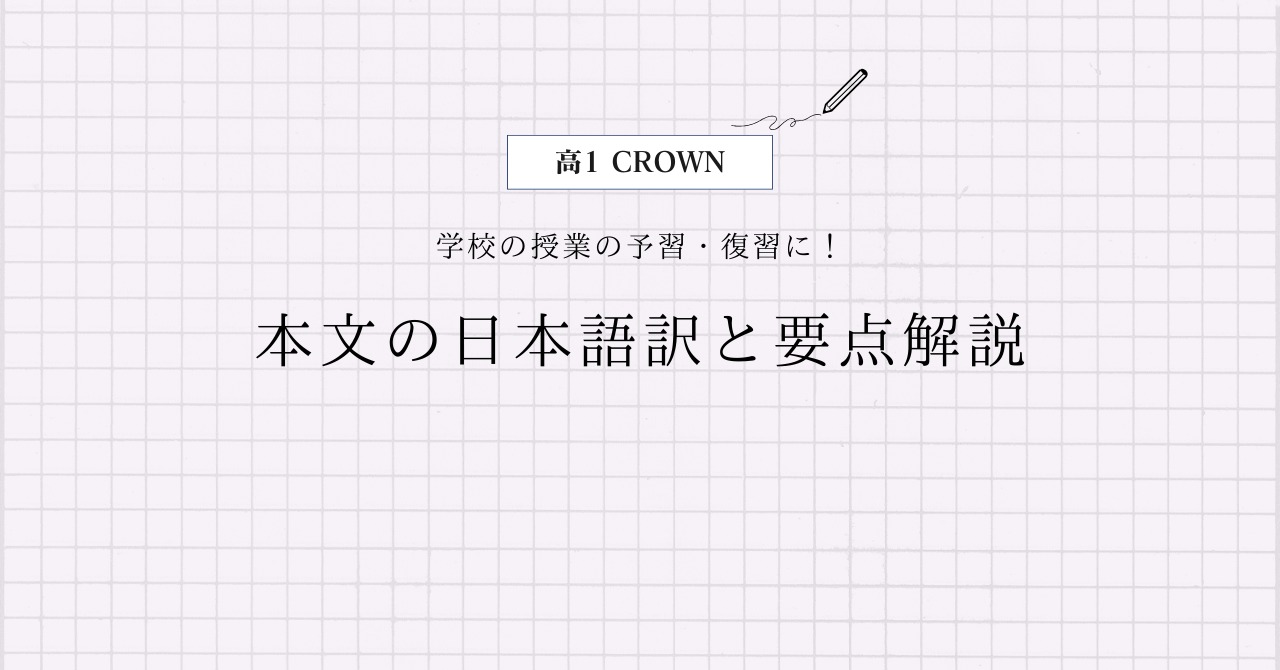三省堂 高1CROWN English Communication1 Lesson9 Section4の本文の日本語訳と重要箇所の解説です。
Section9-1, 9-2, 9-3の解説はこちらからご覧ください。
>高1CROWN English Communication1 Lesson9 Section1 本文和訳
>高1CROWN English Communication1 Lesson9 Section2 本文和訳
>高1CROWN English Communication1 Lesson9 Section3 本文和訳
- CROWN English Communication1 Lesson9 Section4 本文と日本語訳
- CROWN English Communication1 Lesson9 Section4 重要事項の解説
- Critics say that the real reason the British Museum refuses to return the Rapa Nui’s Lost Friend is quite different.
- Hoa Hakananaia is not the only artwork that was taken without permission.
- The British Museum got many of its artworks during the colonial period (the late 16th through the early 20th century).
- The list includes the Parthenon Marbles from Greece, the Rosetta Stone from Egypt, and the Benin Bronzes from present day Nigeria.
- And then there are some 23,000 Chinese artworks.
- The owners are asking for the return of their stolen treasures.
- If the museum returns the Lost Friend, it would set a precedent.
- Museums all over the world face similar problems.
- Who is the rightful owner of works of art that are hundreds or even thousands of years old?
- These works are now part of our priceless world heritage.
- And even if the rightful owners can be found, can they be trusted to keep these works safe?
- One can argue that great art belongs to the entire world and should be displayed where it can be safely viewed by the largest number of people.
- However, for the Rapa Nui people, these questions are less important than the simple human desire to bring home their lost family member, their Lost Friend.
- CROWN English Communication1 Lesson9 Section4 まとめ
CROWN English Communication1 Lesson9 Section4 本文と日本語訳
Critics say that the real reason the British Museum refuses to return the Rapa Nui’s Lost Friend is quite different.
「評論家は、大英博物館がラパ・ヌイの失われた友人を返却するのを拒む本当の理由は大きく異なると言います。」
Hoa Hakananaia is not the only artwork that was taken without permission.
「ホア・ハカナナイアは許可なしに持って行かれた唯一の芸術作品ではありません。」
The British Museum got many of its artworks during the colonial period (the late 16th through the early 20th century).
「大英博物館は植民地時代(16世紀末期から20世紀初期まで)に、博物館にある芸術作品の多くを手に入れました。」
The list includes the Parthenon Marbles from Greece, the Rosetta Stone from Egypt, and the Benin Bronzes from present day Nigeria.
「リストには、ギリシャのエルギン・マーブル、エジプトのロゼッタ・ストーン、現代のナイジェリアのベニン・ブロンズが含まれています。」
And then there are some 23,000 Chinese artworks.
「そしてそれから、およそ23,000の中国の芸術作品があります。」
The owners are asking for the return of their stolen treasures.
「所有者たちは、盗まれた宝物の返却を求めています。」
If the museum returns the Lost Friend, it would set a precedent.
「もし博物館が失われた友人を返却したら、前例を作ることになります。」
Museums all over the world face similar problems.
「世界中の博物館が同様の問題に直面しています。」
Who is the rightful owner of works of art that are hundreds or even thousands of years old?
「だれが何百、何千年もの歴史がある芸術作品の正当な所有者なのでしょうか?」
These works are now part of our priceless world heritage.
「これらの作品は、今では私たちの貴重な世界遺産の一部です。」
And even if the rightful owners can be found, can they be trusted to keep these works safe?
「そして、たとえもし正当な所有者が見つかったとしても、彼らが作品を安全に保管してくれると信用されるでしょうか?」
One can argue that great art belongs to the entire world and should be displayed where it can be safely viewed by the largest number of people.
「素晴らしい芸術は世界全体の所有物であって最大数の人々に安全に見てもらえる場所に展示すべきだとも言えます。」
However, for the Rapa Nui people, these questions are less important than the simple human desire to bring home their lost family member, their Lost Friend.
「しかし、ラパ・ヌイの人々にとってこれらの問題は、失われた友人、失われた家族の一員を家に連れ帰りたいという当たり前の人間の願望よりと比べると重要ではありません。」

CROWN English Communication1 Lesson9 Section4 重要事項の解説
Critics say that the real reason the British Museum refuses to return the Rapa Nui’s Lost Friend is quite different.
“critic”は「批評家、評論家」、“reason”は「理由」、“the British Museum”は「大英博物館」といった名詞で、“real”は「本当の」という形容詞ですね。
“say”の後ろには「接続詞that」があります。
“reason”の後ろには「同格のthat」が省略されていて、“the British Museum refuses to return the Rapa Nui’s Lost Friend”と“the real reason”がイコール関係になっています。「~という理由」と訳してあげましょう。
ただし、今回のように「同格のthat」が省略されるのは珍しく、ふつうは省略せずに書いてありますよ。
“refuse”は「を拒む」、“return”は「戻る、を返却する」という動詞で、“to return”は「不定詞の名詞的用法」になっています。
“quite”は「かなり、まったく」という副詞で、“different”は「異なった」という形容詞です。今回は「大きく異なる」としました。
Hoa Hakananaia is not the only artwork that was taken without permission.
“only”は「唯一の」という形容詞、“artwork”は「芸術作品」という名詞です。
“that”は「主格の関係代名詞」で、“that was taken without permission”が先行詞“the only artwork”を修飾しています。
今回のように先行詞に“only”が付いている場合は、“which/who”ではなく“that”を使います。
“taken”は“take(を持って行く、連れて行く)”の過去分詞形で、ここでは「受動態」になっていますね。
“without”は「~なしで」という前置詞で、“permission”は「許可」という名詞になります。
The British Museum got many of its artworks during the colonial period (the late 16th through the early 20th century).
“many of 複数名詞”は「~のたくさん」という意味で、“its”は“The British Museum”を指しています。
“during”は「~の間」という前置詞、“colonial”は「植民地の」、“period”は「時代」という名詞になります。
“late”は「末期の」、“early”は「初期の」という形容詞、“through”は「~を通して、~に至るまで」といった前置詞、“century”は「世紀」という名詞ですね。
The list includes the Parthenon Marbles from Greece, the Rosetta Stone from Egypt, and the Benin Bronzes from present day Nigeria.
“list”は「リスト、一覧表」、“Greece”は「ギリシャ」、“Egypt”は「エジプト」、“Nigeria”は「ナイジェリア」という名詞ですね。
“include”は「を含む」という動詞で、“present day”は「現代の」という形容詞的な表現になります。
今回は「リストには~が含まれている」という受動態のような訳にしてあります。
And then there are some 23,000 Chinese artworks.
“then”は「それから,そのとき,それでは」といった意味の副詞です。文に応じて柔軟に訳してあげてください。
また、この文は「there構文」になっていますね。
“some”は後ろに数字を置くと「およそ、約」といった副詞になります。
The owners are asking for the return of their stolen treasures.
“owner”は「所有者」、“return”は「返却」、“treasure”は「宝物」という名詞です。
“ask for~”は「~を求める」という表現で、ここでは「現在進行形」になっていますね。
“their”は“The owners”を指していて、“stolen”は“steal(を盗む)”の過去分詞形です。
また、“stolen”は「過去分詞」として“treasures”を修飾していますね。
If the museum returns the Lost Friend, it would set a precedent.
この文では「接続詞if」が使われています。
“museum”は「博物館、美術館」、“precedent”は「前例」という名詞です。
“would”は、本来は助動詞“will”の過去形ですが、ここでは「~だろう」という“will”よりも低い可能性を示す意味で使われています。
“set”は「をつくる、を決める」といった動詞ですね。
Museums all over the world face similar problems.
“all over the world”は「世界中」という表現ですね。
“face”は「に直面する」という動詞で、“similar”は「同様の」という形容詞、“problem”は「問題」という名詞です。
Who is the rightful owner of works of art that are hundreds or even thousands of years old?
“rightful”は「正当な、公平な」という形容詞、“work”は「作品」、“art”は「芸術」という名詞です。
“of”は前置詞で,”A of B”の形で「BのA」というように後ろから前に訳します。
“that”は「主格の関係代名詞」で、“that are hundreds or even thousands of years old”が先行詞“works of art”を修飾しています。
“hundreds of~”は「何百もの~」、“thousands of~”は「何千もの~」という意味で、“even”は「~さえ」といった強調を表す副詞です。“years old”は「~歳」ですね。
直訳すると「何百、何千歳もの~」となりますが、今回は「歴史がある」と訳しました。
These works are now part of our priceless world heritage.
“these”は“this”の複数形で,「これらは(の)」といった意味になります。
“part of~”は「~の一部」という意味で、“priceless”は「貴重な、価値がある」といった形容詞です。
“world heritage”は「世界遺産」ですね。
And even if the rightful owners can be found, can they be trusted to keep these works safe?
“even if”は「たとえもし~」という意味の接続詞になります。
“found”は“find(を見つける)”の過去分詞形で、ここでは助動詞と「受動態」がセットになっていますね。
“they”は”the rightful owners”を指していて、“trust”は「を信頼する」という動詞です。ここも助動詞と「受動態」がセットになっています。
“keep 名詞 形容詞”は「名詞を~(の状態)に保つ」といった重要表現で、“safe”は「安全な」という形容詞ですね。
One can argue that great art belongs to the entire world and should be displayed where it can be safely viewed by the largest number of people.
“one can argue that~”は「~とも言える」という表現になります。
“great”は「凄い、素晴らしい」、“entire”は「全体の」という形容詞で、“belong to~”は「に所属する、の所有物である」という重要表現です。
“should”は「~すべきだ、~のはずだ」という助動詞で、“display”は「を表示する、展示する」という動詞です。ここでは助動詞と「受動態」がセットになっていますね。
“where”は「関係副詞」で、ここでは“in the place that(which)”の代わりになっています。
“it”は“great art”を指していて、“safely”は「安全に」という副詞、“view”は「を見る、眺める」という動詞ですね。ここも助動詞と「受動態」がセットになっています。
“the number of~”は「~の数」という表現で、“the largest”という「最上級」がついて「最大数の~」となります。
However, for the Rapa Nui people, these questions are less important than the simple human desire to bring home their lost family member, their Lost Friend.
“however”は「しかし」という意味の副詞になります。
同じ意味で“but”がありますが,こちらは接続詞なので品詞が異なります。“but”は“文A,but 文B”というように,2つの文を繋ぐ際に使います。
“文A. But 文B.”というように,“but”を文の先頭に置いて1文だけで完結させるのは原則NGとなります。
“less”は「比較級」の否定を表します。この場合、後ろの形容詞/副詞は原級でOKです。
“simple”は「単純な、ふつうの」といった形容詞で、“human”は「人間」、“desire”は「願望、欲望」という名詞です。
“to bring”は「不定詞の形容詞的用法」になっていて、“desire”を修飾していますね。
“bring home 名詞”で「名詞を家に持って帰る」といった意味になります。
“their lost family member”と“their Lost Friend”は「同格語」になります。“名詞,名詞”の並びは「同格語」の可能性が高いですよ!“their”は“the Rapa Nui people”を指していますね。
CROWN English Communication1 Lesson9 Section4 まとめ
以上がCROWN English Communication1 Lesson9 Section4の日本語訳となります。
「比較」「関係詞」などの使い方をしっかり確認しておきましょう!
>高1CROWN English Communication1 Lesson9 Section1 本文和訳
>高1CROWN English Communication1 Lesson9 Section2 本文和訳
>高1CROWN English Communication1 Lesson9 Section3 本文和訳
何か分からない点や他に解説してほしい点があれば,お気軽にコメントしてください!



コメント